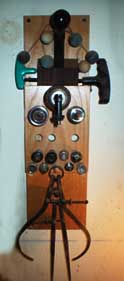Lathe "accessories" (which soon become "necessities") are like chocolates - you can't have enough. Other than a router table - with all the router bits who's numbers increase over time, a lathe probably has more accessories than any other machine in your shop. Unlike router bits, which you can store a ton of in relativley little space, lathe support / enhancement tools (sounds better than "accessories) come in a broad range of sizes, shapes and weights. Keeping track of them get's tricky pretty quickly - especially if you hide them in a drawer, or worse yet, leave them on the bench top and then cover them up with shavings. You could stash them on a shelf or two UNDER the bench top - then sit on the floor and move things around 'til you find what you're looking for.
BUT - if you've got 'em out where you can find them easily - WITHOUT HAVING TO BEND OVER - and it's easy to put them back where they came from, well . . .
A board with some pegs, drill a few holes, a little glue and you're problem's solved - right? Screw it to the wall near the lathe - up where you can reach it - WITHOUT HAVING TO BEND OVER.
That's how easy it COULD'VE been. I seldom do things the easy way. Rather than use JUST dowels - why not turn them - out of maple? And I've got all this Finnish Birch ply (free). Why not shellac everything once things are all sanded and finished? One small, itty-bitty problem. Chucks are heavy, and while balanced to be symetric about their axis of rotation, their weight distribution isn't symetric front to back. Better slant their beefier pegs upward.

Of course the layout was a wee bit time consuming. How much stuff can I pack into the minimum amount of space? If you look at the leftmost picture below and start counting - it'll store - 2 Lathe Chucks - with jaws, - 6 Tool Rests, - 3 Chuck Jaw Sets AND a faceplate. You can get to any of them without having to move anything else - just slip 'em off their peg(s).

Now what about drive centers, dead centers, a jacobs chuck, calipers, allen wrenches for the chucks, burning wires - and an awl to poke the centers of the ends of blanks? Another piece of ply, a bunch of slanted holes, a few pegs, a block of wood with horizontal holes for the chuck's allen wrenches, another block of wood with some grooves for the burn wires and a hole for the awl.

Turning tools work a lot better if they're sharp. When the edge is gone, you can still get the gouge or chisel to remove wood - but the results won't be pretty. A grinder based sharpening system nearby would be handy - but usually what's needed is an edge "touch up" rather than serious grinding to reshape it. The JoolTool is the perfect lathe bench tool for restoring or touching up a cutting edge. Small footprint, no need for special jigs - you're the jig, no grinding wheel dust to deal with, and, because it can be set up right next to where you're turning, there's no excuse not to touch up the edge as soon as you notice your tool is beginning to dull. However, as you can see in the photo below, there are seven "ninja" wheels, a polishing wheel and a felt wheel, along with a black felt tip or two for marking the surface to be worked on. You don't want different abrassive grits in contact with each other so throwing them in a box or drawer is out of the question. Another piece of ply, some holes for small pegs and a chunk of wood routed to make an L-shaped shelf for the black felt tip pen use with the JoolTool and then its Screw It To The Wall Time.

Five months later here's what the lathe area looks like. Look close and you may actually find the lathe.

Comments, Suggestions, Constructive Criticism e-mail me